A Ferroelectric-Photovoltaic Effect in SbSI Nanowires
Abstract
1. Introduction
2. Materials and Methods
3. Results
4. Discussion
5. Conclusions
Supplementary Materials
Author Contributions
Funding
Acknowledgments
Conflicts of Interest
References
- Liang, L.; Kang, X.; Sang, Y.; Liu, H. One-Dimensional Ferroelectric Nanostructures: Synthesis, Properties, and Applications. Adv. Sci. 2016, 3, 1500358. [Google Scholar] [CrossRef]
- Mistewicz, K. Recent Advances in Ferroelectric Nanosensors: Toward Sensitive Detection of Gas, Mechanothermal Signals, and Radiation. J. Nanomater. 2018, 2018, 1–15, 2651056. [Google Scholar] [CrossRef]
- Yang, Y.; Jung, J.H.; Yun, B.K.; Zhang, F.; Pradel, K.C.; Guo, W.; Wang, Z.L. Flexible Pyroelectric Nanogenerators using a Composite Structure of Lead-Free KNbO3 Nanowires. Adv. Mater. 2012, 24, 5357–5362. [Google Scholar] [CrossRef]
- Ganeshkumar, R.; Cheah, C.W.; Xu, R.; Kim, S.-G.; Zhao, R. A high output voltage flexible piezoelectric nanogenerator using porous lead-free KNbO3 nanofibers. Appl. Phys. Lett. 2017, 111, 013905-1–013905-5. [Google Scholar] [CrossRef]
- Mistewicz, K.; Nowak, M.; Stróż, D.; Paszkiewicz, R. SbSI nanowires for ferroelectric generators operating under shock pressure. Mater. Lett. 2016, 180, 15–18. [Google Scholar] [CrossRef]
- Guo, R.; You, L.; Zhou, Y.; Lim, Z.S.; Zou, X.; Chen, L.; Ramesh, R.; Wang, J. Non-volatile memory based on the ferroelectric photovoltaic effect. Nat. Commun. 2013, 4, 1990. [Google Scholar] [CrossRef] [PubMed]
- Mistewicz, K.; Nowak, M.; Stróż, D.; Guiseppi-Elie, A. Ferroelectric SbSI nanowires for ammonia detection at a low temperature. Talanta 2018, 189, 225–232. [Google Scholar] [CrossRef] [PubMed]
- Mistewicz, K.; Nowak, M.; Paszkiewicz, R.; Guiseppi-Elie, A. SbSI Nanosensors: From Gel to Single Nanowire Devices. Nanoscale Res. Lett. 2017, 12, 97–104. [Google Scholar] [CrossRef]
- Ma, N.; Zhang, K.; Yang, Y. Photovoltaic–Pyroelectric Coupled Effect Induced Electricity for Self-Powered Photodetector System. Adv. Mater. 2017, 29, 1703694. [Google Scholar] [CrossRef]
- Lopez-Varo, P.; Bertoluzzi, L.; Bisquert, J.; Alexe, M.; Coll, M.; Huang, J.; Jimenez-Tejada, J.A.; Kirchartz, T.; Nechache, R.; Rosei, F.; et al. Physical aspects of ferroelectric semiconductors for photovoltaic solar energy conversion. Phys. Rep. 2016, 653, 1–40. [Google Scholar] [CrossRef]
- Chen, B.; Shi, J.; Zheng, X.; Zhou, Y.; Zhuc, K.; Priya, S. Ferroelectric solar cells based on inorganic–organic hybrid perovskites. Mater. Chem. A 2015, 3, 7699–7705. [Google Scholar] [CrossRef]
- Butler, K.T.; Frost, J.M.; Walsh, A. Ferroelectric materials for solar energy conversion: Photoferroics revisited. Energy Environ. Sci. 2015, 8, 838–848. [Google Scholar] [CrossRef]
- Liu, H.; Chen, J.; Ren, Y.; Zhang, L.; Pan, Z.; Fan, L.; Xing, X. Large Photovoltage and Controllable Photovoltaic Effect in PbTiO3-Bi(Ni2/3+xNb1/3–x)O3–δ Ferroelectrics. Adv. Electron. Mater. 2015, 1, 1400051. [Google Scholar] [CrossRef]
- Matsuo, H.; Noguchi, Y.; Miyayama, M. Gap-state engineering of visible-light-active ferroelectrics for photovoltaic applications. Nat. Commun. 2017, 8, 207. [Google Scholar] [CrossRef]
- Ji, B.W.; Yao, K.; Liang, Y.C. Bulk Photovoltaic Effect at Visible Wavelength in Epitaxial Ferroelectric BiFeO3 Thin Films. Adv. Mater. 2010, 22, 1763–1766. [Google Scholar] [CrossRef]
- Bai, Z.; Zhang, Y.; Guo, H.; Jiang, A. The Influence of Conductive Nanodomain Walls on the Photovoltaic Effect of BiFeO3 Thin Films. Crystals 2017, 7, 81. [Google Scholar] [CrossRef]
- Yang, S.Y.; Seidel, J.; Byrnes, S.J.; Shafer, P.; Yang, C.-H.; Rossell, M.D.; Yu, P.; Chu, Y.-H.; Scott, J.F.; Ager, J.W.; et al. Above-bandgap voltages from ferroelectric photovoltaic devices. Nat. Nanotechnol. 2010, 5, 143–147. [Google Scholar] [CrossRef]
- Hu, L.; Dalgleish, S.; Matsushita, M.M.; Yoshikawa, H.; Awaga, K. Storage of an electric field for photocurrent generation in ferroelectric-functionalized organic devices. Nat. Commun. 2014, 5, 3279. [Google Scholar] [CrossRef]
- He, H.; He, Z.; Jiang, Z.; Wang, J.; Liu, T.; Wang, N. A controllable photoresponse and photovoltaic performance in Bi4Ti3O12 ferroelectric thin films. J. Alloys Compd. 2017, 694, 998–1003. [Google Scholar] [CrossRef]
- Wang, C.; Cao, D.; Zheng, F.; Dong, W.; Fang, L.; Su, X.; Shen, M. Photocathodic behavior of ferroelectric Pb(Zr,Ti)O3 films decorated with silver nanoparticles. Chem. Commun. 2013, 49, 3769–3771. [Google Scholar] [CrossRef]
- Kooriyattil, S.; Katiyar, R.K.; Pavunny, S.P.; Morell, G.; Katiyar, R.S. Photovoltaic properties of Aurivillius phase Bi5FeTi3O15 thin films grown by pulsed laser deposition. Appl. Phys. Lett. 2014, 105, 072908-1–072908-4. [Google Scholar] [CrossRef]
- Zhang, J.; Su, X.; Shen, M.; Dai, Z.; Zhang, L.; He, X.; Cheng, W.; Cao, M.; Zou, G. Enlarging photovoltaic effect: Combination of classic photoelectric and ferroelectric photovoltaic effects. Sci. Rep. 2013, 3, 2109. [Google Scholar] [CrossRef]
- Yi, H.T.; Choi, T.; Choi, S.G.; Oh, Y.S.; Cheong, S.-W. Mechanism of the Switchable Photovoltaic Effect in Ferroelectric BiFeO3. Adv. Mater. 2011, 23, 3403–3407. [Google Scholar] [CrossRef]
- Spanier, J.E.; Fridkin, V.M.; Rappe, A.M.; Akbashev, A.R.; Polemi, A.; Qi, Y.; Gu, Z.; Young, S.M.; Hawley, C.J.; Imbrenda, D.; et al. Power conversion efficiency exceeding the Shockley–Queisser limit in a ferroelectric insulator. Nat. Photonics 2016, 10, 611–616. [Google Scholar] [CrossRef]
- Grinberg, I.; West, D.V.; Torres, M.; Gou, G.; Stein, D.M.; Wu, L.; Chen, G.; Gallo, E.M.; Akbashev, A.R.; Davies, P.K.; et al. Perovskite oxides for visible-light-absorbing ferroelectric and photovoltaic materials. Nature 2013, 503, 509–512. [Google Scholar] [CrossRef]
- Qin, M.; Yao, K.; Liang, Y.C. High efficient photovoltaics in nanoscaled ferroelectric thin films. Appl. Phys. Lett. 2008, 93, 122904. [Google Scholar] [CrossRef]
- Eskandari, R.; Zhang, X.; Malkinski, L.M. Polarization-dependent photovoltaic effect in ferroelectric-semiconductor system. Appl. Phys. Lett. 2017, 110, 121105. [Google Scholar] [CrossRef]
- Laurenti, M.; Canavese, G.; Sacco, A.; Fontana, M.; Bejtka, K.; Castellino, M.; Pirri, C.F.; Cauda, V. Nanobranched ZnO Structure: P-Type Doping Induces Piezoelectric Voltage Generation and Ferroelectric–Photovoltaic Effect. Adv. Mater. 2015, 27, 4218–4223. [Google Scholar] [CrossRef]
- You, L.; Zheng, F.; Fang, L.; Zhou, Y.; Tan, L.Z.; Zhang, Z.; Ma, G.; Schmidt, D.; Rusydi, A.; Wang, L.; et al. Enhancing ferroelectric photovoltaic effect by polar order engineering. Sci. Adv. 2018, 4, eaat3438. [Google Scholar] [CrossRef]
- Fei, L.; Hu, Y.; Li, X.; Song, R.; Sun, L.; Huang, H.; Gu, H.; Chan, H.L.W.; Wang, Y. Electrospun Bismuth Ferrite Nanofibers for Potential Applications in Ferroelectric Photovoltaic Devices. ACS Appl. Mater. Interfaces 2015, 7, 3665–3670. [Google Scholar] [CrossRef]
- Khan, G.; Das, R.; Mukherjee, N.; Mandal, K. Effect of metal doping on highly efficient photovoltaics and switchable photovoltage in bismuth ferrite nanotubes. Phys. Status Solidi RRL 2012, 6, 312–314. [Google Scholar] [CrossRef]
- Fridkin, V.M.; Rodin, A.I. Anomalous photovoltaic effect in ferroelectric SbSI and cubic piezoelectric ZnS. Phys. Status Solidi A 1980, 61, 123–126. [Google Scholar] [CrossRef]
- Akopov, D.R.; Grekov, A.A.; Rodin, A.I. Anomalous photovoltaic effect in AVBVICVII ferroelectrics. Ferroelectrics 1980, 26, 855–858. [Google Scholar] [CrossRef]
- Butler, K.T.; McKechnie, S.; Azarhoosh, P.; van Schilfgaarde, M.; Scanlon, D.O.; Walsh, A. Quasi-particle electronic band structure and alignment of the V-VI-VII semiconductors SbSI, SbSBr, and SbSeI for solar cells. Appl. Phys. Lett. 2016, 108, 112103-1–112103-4. [Google Scholar] [CrossRef]
- Nie, R.; Yun, H.-S.; Paik, M.-J.; Mehta, A.; Park, B.-W.; Choi, Y.C.; Seok, S.I. Efficient Solar Cells Based on Light-Harvesting Antimony Sulfoiodide. Adv. Energy Mater. 2018, 8, 1701901. [Google Scholar] [CrossRef]
- Choi, Y.C.; Hwang, E.; Kim, D.-H. Controlled growth of SbSI thin films from amorphous Sb2S3 for low-temperature solution processed chalcohalide solar cells. APL Mater. 2018, 6, 121108. [Google Scholar] [CrossRef]
- Ogawa, N.; Sotome, M.; Kaneko, Y.; Ogino, M.; Tokura, Y. Shift current in the ferroelectric semiconductor SbSI. Phys. Rev. B 2017, 96, 241203I. [Google Scholar] [CrossRef]
- Nakamura, M.; Hatada, H.; Kaneko, Y.; Ogawa, N.; Tokura, Y.; Kawasaki, M. Impact of electrodes on the extraction of shift current from a ferroelectric semiconductor SbSI. Appl. Phys. Lett. 2018, 113, 232901. [Google Scholar] [CrossRef]
- Burger, A.M.; Agarwal, R.; Aprelev, A.; Schruba, E.; Gutierrez-Perez, A.; Fridkin, V.M.; Spanier, J.E. Direct observation of shift and ballistic photovoltaic currents. Sci. Adv. 2019, 5, eaau5588. [Google Scholar] [CrossRef]
- Sotome, M.; Nakamura, M.; Fujioka, J.; Ogino, M.; Kaneko, Y.; Morimotod, T.; Zhang, Y.; Kawasaki, M.; Nagaosa, N.; Tokura, Y.; et al. Spectral dynamics of shift current in ferroelectric semiconductor SbSI. Proc. Natl. Acad. Sci. USA 2019, 116, 1929–1933. [Google Scholar] [CrossRef]
- Nakamura, M.; Horiuchi, S.; Kagawa, F.; Ogawa, N.; Kurumaji, T.; Tokura, Y.; Kawasaki, M. Shift current photovoltaic effect in a ferroelectric charge-transfer complex. Nat. Commun. 2017, 8, 1–6. [Google Scholar] [CrossRef]
- Nowak, M.; Nowrot, A.; Szperlich, P.; Jesionek, M.; Kępińska, M.; Starczewska, A.; Mistewicz, K.; Stróż, D.; Szala, J.; Rzychoń, T.; et al. Fabrication and characterization of SbSI gel for humidity sensors. Sens. Actuators A 2014, 210, 119–130. [Google Scholar] [CrossRef]
- Nowak, M.; Szperlich, P.; Bober, Ł.; Szala, J.; Moskal, G.; Stróż, D. Sonochemical preparation of SbSI gel. Ultrason. Sonochem. 2008, 15, 709–716. [Google Scholar] [CrossRef] [PubMed]
- Kortum, G. Reflectance Spectroscopy: Principles, Methods, Applications; Springer: Berlin, Germany, 1969. [Google Scholar]
- Mistewicz, K.; Nowak, M.; Starczewska, A.; Jesionek, M.; Rzychoń, T.; Wrzalik, R.; Guiseppi-Elie, A. Determination of electrical conductivity type of SbSI nanowires. Mater. Lett. 2016, 182, 78–80. [Google Scholar] [CrossRef]
- Nowak, M.; Talik, E.; Szperlich, P.; Stróż, D. XPS analysis of sonochemically prepared SbSI ethanogel. Appl. Surf. Sci. 2009, 255, 7689–7694. [Google Scholar] [CrossRef]
- Nowak, M.; Mistewicz, K.; Nowrot, A.; Szperlich, P.; Jesionek, M.; Starczewska, A. Transient characteristics and negative photoconductivity of SbSI humidity sensor. Sens. Actuators A 2014, 210, 32–40. [Google Scholar] [CrossRef]
- Antimony Sulfide Iodide, JCPDS-International Centre for Diffraction Data, PCPDFWIN v.2.1, Card File No. 74-0149. 2000.
- Nowak, M.; Kauch, B.; Szperlich, P. Determination of energy band gap of nanocrystalline SbSI using diffuse reflectance spectroscopy. Rev. Sci. Instrum. 2009, 80, 046107. [Google Scholar] [CrossRef] [PubMed]
- Liao, Z.-M.; Lu, Y.; Xu, J.; Zhang, J.-M.; Yu, D.-P. Temperature dependence of photoconductivity and persistent photoconductivity of single ZnO nanowires. Appl. Phys. A 2009, 95, 363–366. [Google Scholar] [CrossRef]
- Yuan, Y.; Xiao, Z.; Yang, B.; Huang, J. Arising applications of ferroelectric materials in photovoltaic devices. J. Mater. Chem. A 2014, 2, 6027–6041. [Google Scholar] [CrossRef]
- Nowak, M.; Szperlich, P. Temperature dependence of energy band gap and spontaneous polarization of SbSI nanowires. Opt. Mater. 2013, 35, 1200–1206. [Google Scholar] [CrossRef]
- Nowak, M.; Bober, Ł.; Borkowski, B.; Kępińska, M.; Szperlich, P.; Stróż, D.; Sozańska, M. Quantum efficiency coefficient for photogeneration of carriers in SbSI nanowires. Opt. Mater. 2013, 35, 2208–2216. [Google Scholar] [CrossRef]
- Szperlich, P.; Nowak, M.; Bober, Ł.; Szala, J.; Stróż, D. Ferroelectric properties of ultrasonochemically prepared SbSI ethanogel. Ultrason. Sonochem. 2009, 1, 398–401. [Google Scholar] [CrossRef]
- Fridkin, V.M. Photoferroelectrics; Springer: New York, NY, USA, 1979. [Google Scholar]
- Fatuzzo, E.; Harbeke, G.; Merz, W.J.; Nitsche, R.; Roetschi, H.; Ruppel, W. Ferroelectricity in SbSI. Phys. Rev. 1962, 127, 2036–2037. [Google Scholar] [CrossRef]
- Popik, Y.V.; Betsa, V.V. Electronic state of the surface and local levels in SbSI single crystals. Fiz. Tverd. Tela 1988, 30, 1282–1288. [Google Scholar]
- Zhao, Y.; Liang, C.; Zhang, H.; Li, D.; Tian, D.; Li, G.; Jing, X.; Zhang, W.; Xiao, W.; Liu, Q.; et al. Anomalously large interface charge in polarity-switchable photovoltaic devices: An indication of mobile ions in organic–inorganic halide perovskites. Energy Environ. Sci. 2015, 8, 1256–1260. [Google Scholar] [CrossRef]
- Chen, B.; Zheng, X.; Yang, M.; Zhou, Y.; Kundua, S.; Shic, J.; Zhu, K.; Priya, S. Interface bands structure engineering by ferroelectric polarization in perovskite solar cells. Nano Energy 2015, 13, 582–591. [Google Scholar] [CrossRef]
- Tress, W.; Correa Baena, J.P.; Saliba, M.; Abate, A.; Graetzel, M. Inverted Current–Voltage Hysteresis in Mixed Perovskite Solar Cells: Polarization, Energy Barriers, and Defect Recombination. Adv. Energy Mater. 2016, 6, 1600396. [Google Scholar] [CrossRef]
- Ukai, Y.; Yamazaki, S.; Kawae, T.; Morimoto, A. Polarization-Induced Photovoltaic Effects in Nd-Doped BiFeO3 Ferroelectric Thin Films. Jpn. J. Appl. Phys. 2012, 51, 09LE10. [Google Scholar] [CrossRef]
- Morris, M.R.; Pendlebury, S.R.; Hong, J.; Dunn, S.; Durrant, J.R. Effect of Internal Electric Fields on Charge Carrier Dynamics in a Ferroelectric Material for Solar Energy Conversion. Adv. Mater. 2016, 28, 7123–7128. [Google Scholar] [CrossRef]
- Seki, A.; Funatsu, Y.; Funahashi, M. Anomalous photovoltaic effect based on molecular chirality: Influence of enantiomeric purity on the photocurrent response in p-conjugated ferroelectric liquid crystals. Phys. Chem. Chem. Phys. 2017, 19, 16446. [Google Scholar] [CrossRef]
- Sturman, P.J. Photovoltaic and Photo-Refractive Effects in Noncentrosymmetric Materials; CRC Press: Philadelphia, PA, USA, 1992; 132p. [Google Scholar]
- Cook, A.M.; Fregoso, B.M.; de Juan, F.; Coh, S.; Moore, J.E. Design principles for shift current photovoltaics. Nat. Commun. 2017, 8, 14176. [Google Scholar] [CrossRef]
- Vanderbilt, D.; King-Smith, R.D. Electric polarization as a bulk quantity and its relation to surface charge. Phys. Rev. B 1993, 48, 4442. [Google Scholar] [CrossRef]
- Itoh, K.; Matsunaga, H.; Nakamura, E. Refinement of crystal structure of SbSI in the ferroelectric phase. J. Phys. Soc. Jpn. 1976, 41, 1679–1680. [Google Scholar] [CrossRef]

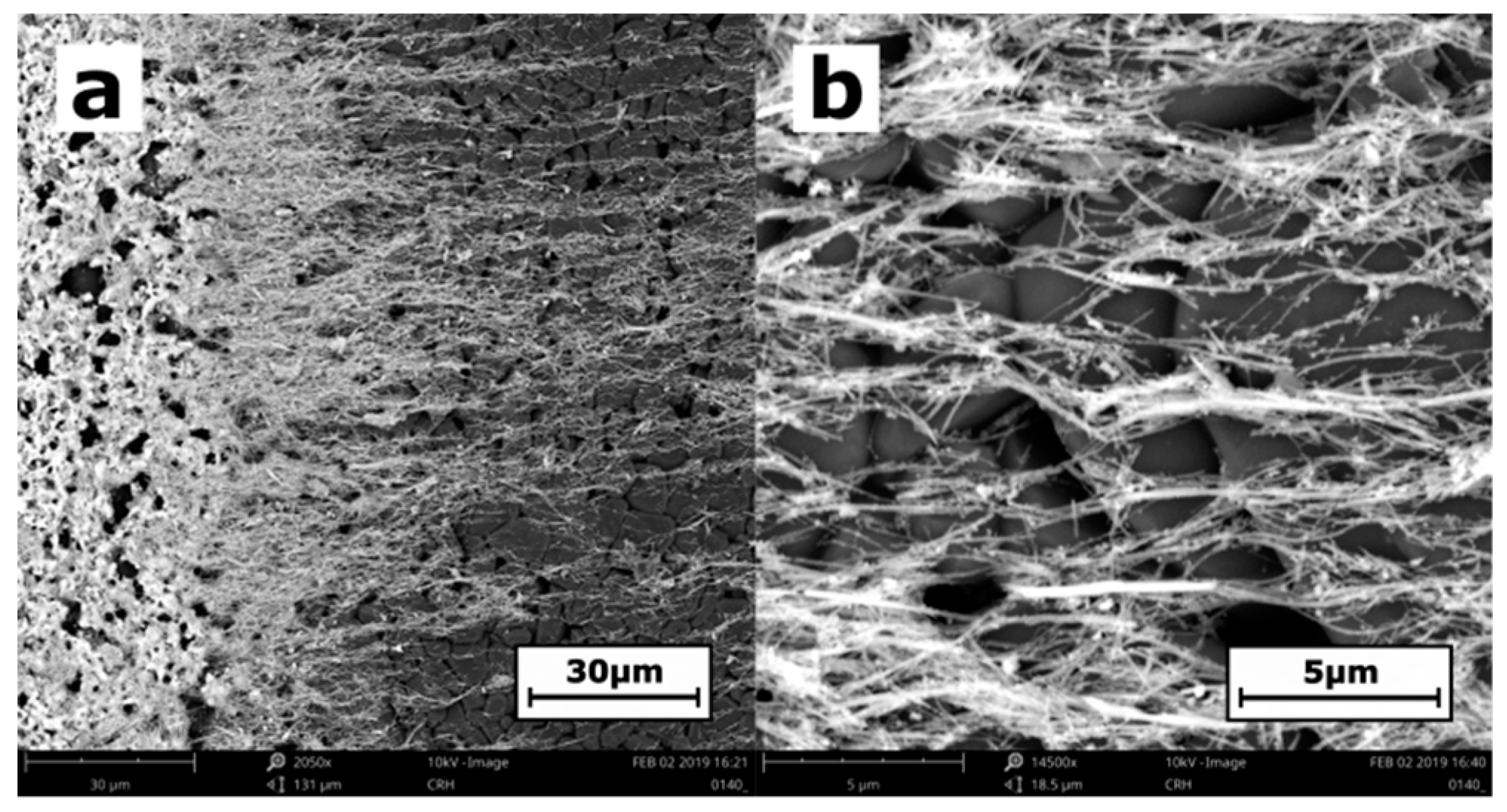
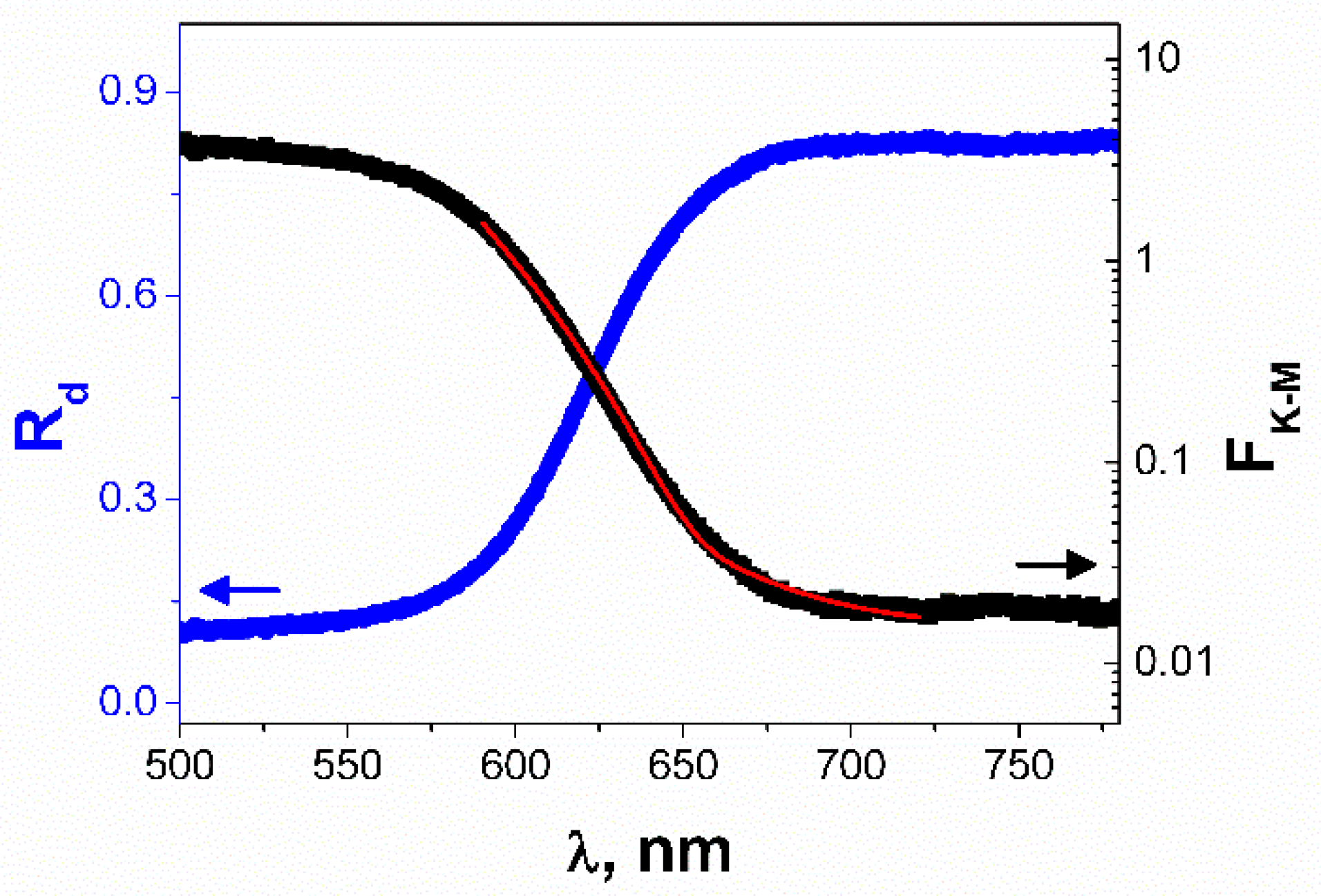
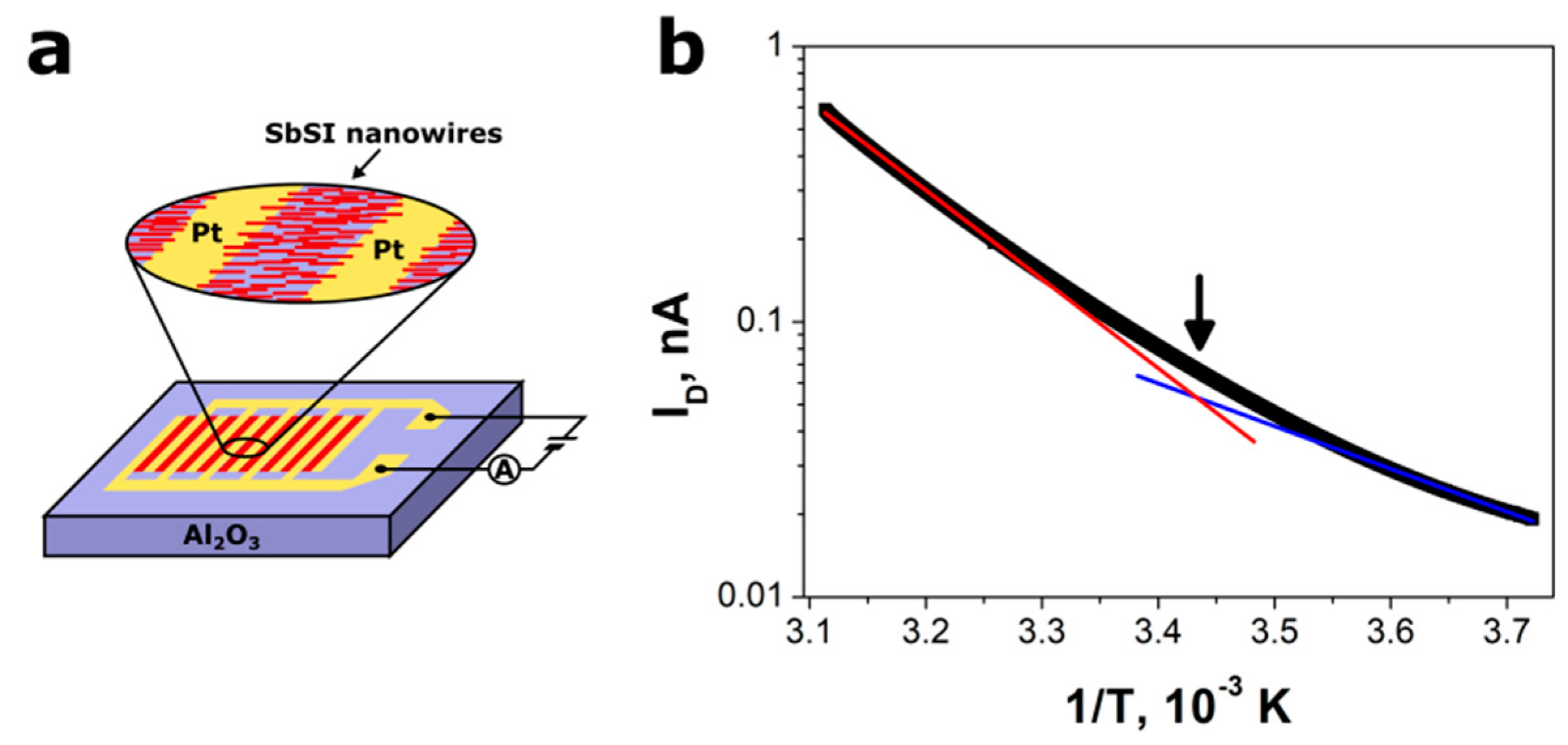


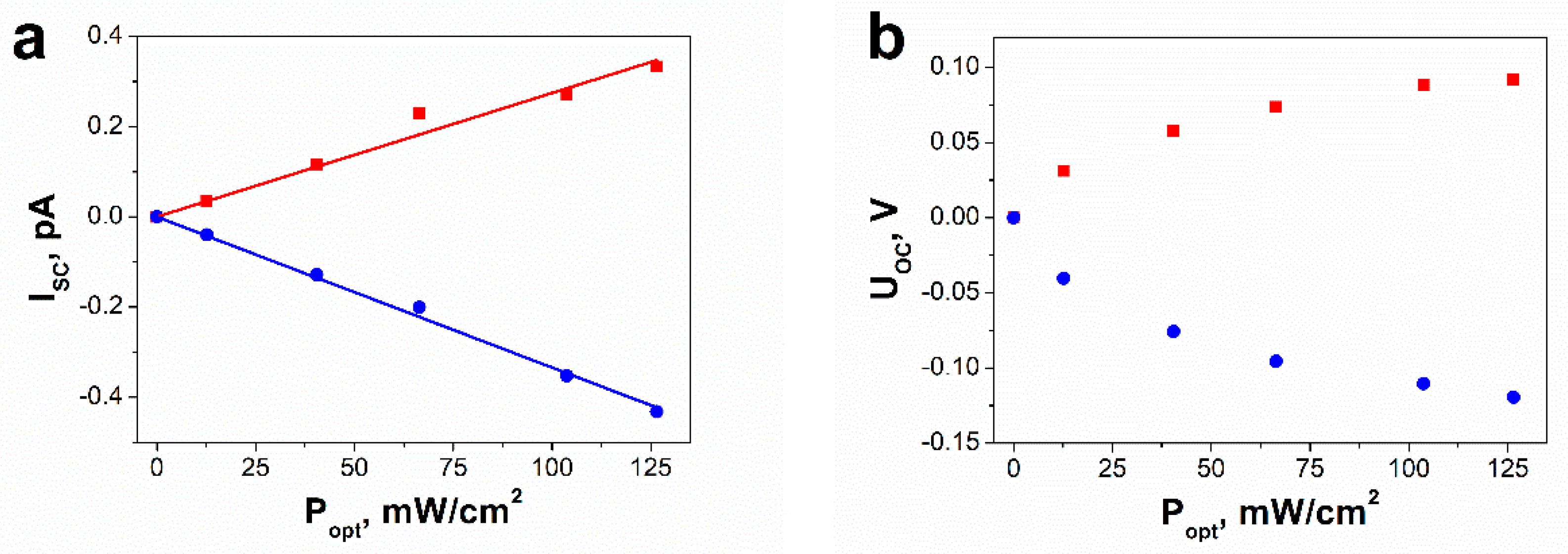
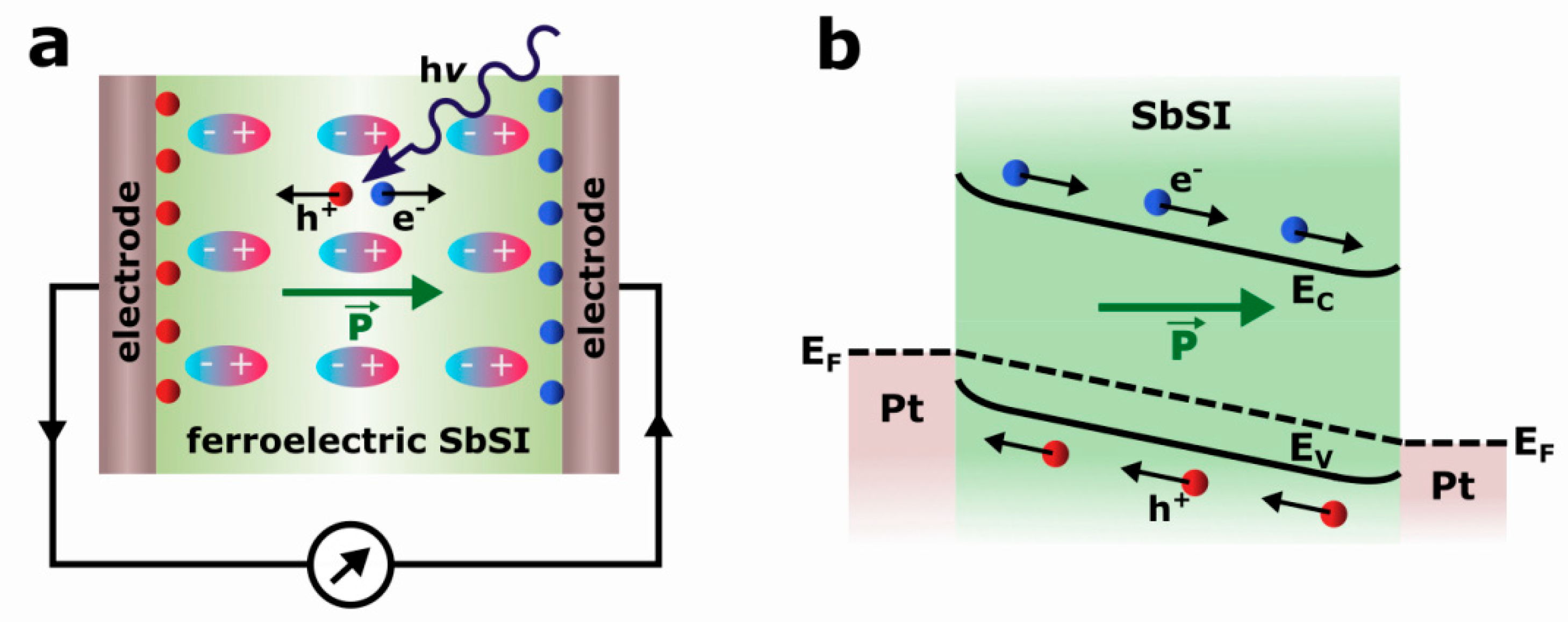
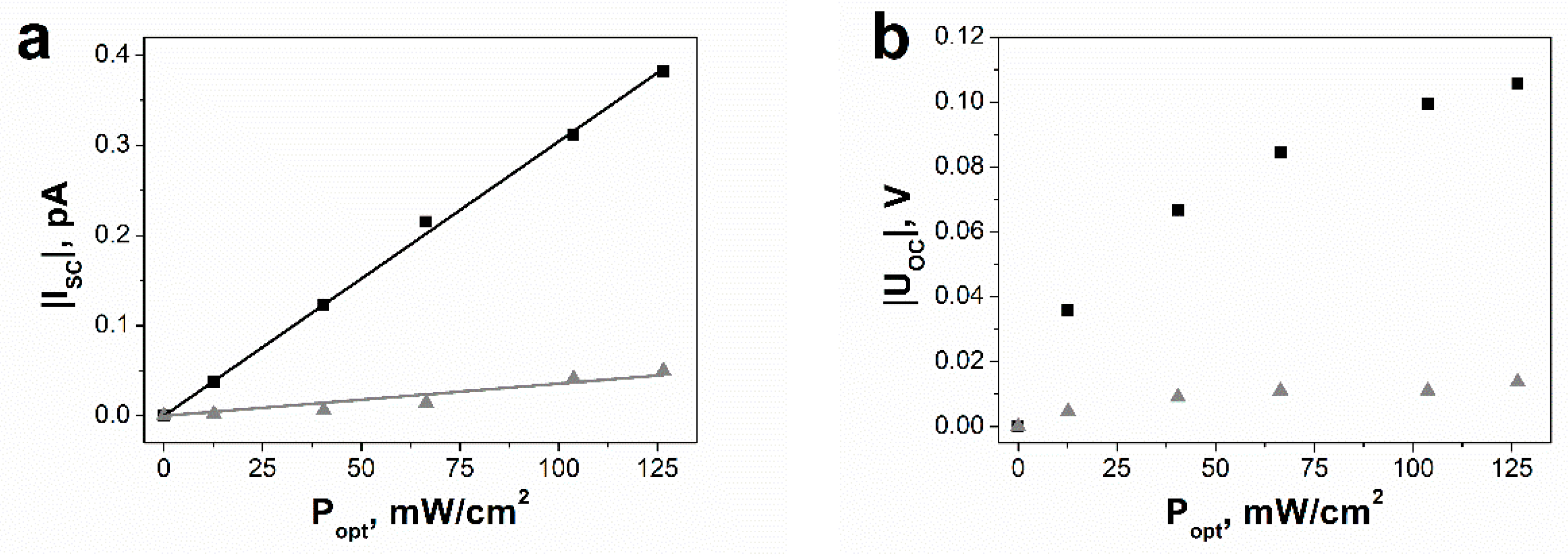
| Fitted Parameters | Values |
|---|---|
| A60, (eV)−3m−1 | 81 (2) |
| EgIf, eV | 1.862 (1) |
| AU, 10−13m−1 | 6.4 (6) |
| EU, eV | 0.078 (3) |
| A0, 10−3m−1 | 14.4 (4) |
| Phase | EA, eV | TC, K |
|---|---|---|
| ferroelectric | 0.3083 (6) | 291 (2) |
| paraelectric | 0.6422 (6) |
| Parameter | Poling Electric Field | |
|---|---|---|
| Positive | Negative | |
| Is, pA | −0.432 (1) | 0.332 (1) |
| I1, pA | −0.51 (2) | 0.716 (7) |
| I2, pA | −0.200 (5) | 0.320 (5) |
| , s | 24 (1) | 85 (2) |
| , min | 5.5 (2) | 12.2 (3) |
| Ferroelectric Nanomaterial | Electrodes | Illumination | JSC, µA/cm2 | UOC, V | Ref. |
|---|---|---|---|---|---|
| PLZT film (d = 68 nm) | AEs: LSMO and Nb:STO | UV (λ = 356 nm; 0.86 mW/cm2) | 2.324 | 0.71 | [26] |
| PZT film with Ag NPs (d = 200 nm) | AEs: ITO and Pt | Xenon lamp (100 mW/cm2) | 110 | 0.76 | [20] |
| Si doped HfO2 film (d = 10 nm) | AEs: Si and Au | AM1.5 (10 mW/cm2) | ~200 | ~0.2 | [27] |
| BIT film (d = 150 nm) | AEs: FTO and Au | AM1.5 (10 mW/cm2) | 0.18 | 0.02 | [19] |
| Sb-doped ZnO nanobranched films | AEs: FTO and Pt | UV (63 mW/cm2) | 0.05 | 0.087 | [28] |
| BFO film (d = 100 nm) | AEs: LSMO and Fe/Pt | Halogen lamp (20 mW/cm2) | - | 0.21 | [6] |
| BFO film (d = 120 nm) | AEs: LSMO and Pt | Halogen lamp (100 mW/cm2) | ~2 | ~0.5 | [29] |
| BFO film (d = 170 nm) | AEs: ITO and SRO | Xenon lamp (λ = 435 nm; 0.75 mW/cm2) | ~0.4 | 0.3 | [15] |
| BFO NFs | SEs: Au IDEs | AM1.5 (10 mW/cm2) | ~0.31 | 0.8 | [30] |
| Pr-doped BFO NTs | SEs: Ag | AM1.5 (10 mW/cm2) | 0.356 | 0.21 | [31] |
| SbSI NWs | SEs: Pt IDEs | Argon laser (λ = 488 nm; 127 mW/cm2) | >0.0074 | 0.119(2) | this paper |
© 2019 by the authors. Licensee MDPI, Basel, Switzerland. This article is an open access article distributed under the terms and conditions of the Creative Commons Attribution (CC BY) license (http://creativecommons.org/licenses/by/4.0/).
Share and Cite
Mistewicz, K.; Nowak, M.; Stróż, D. A Ferroelectric-Photovoltaic Effect in SbSI Nanowires. Nanomaterials 2019, 9, 580. https://doi.org/10.3390/nano9040580
Mistewicz K, Nowak M, Stróż D. A Ferroelectric-Photovoltaic Effect in SbSI Nanowires. Nanomaterials. 2019; 9(4):580. https://doi.org/10.3390/nano9040580
Chicago/Turabian StyleMistewicz, Krystian, Marian Nowak, and Danuta Stróż. 2019. "A Ferroelectric-Photovoltaic Effect in SbSI Nanowires" Nanomaterials 9, no. 4: 580. https://doi.org/10.3390/nano9040580
APA StyleMistewicz, K., Nowak, M., & Stróż, D. (2019). A Ferroelectric-Photovoltaic Effect in SbSI Nanowires. Nanomaterials, 9(4), 580. https://doi.org/10.3390/nano9040580







